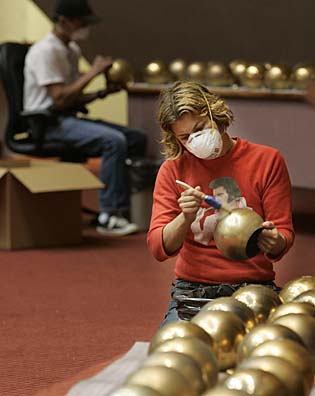
|
New dawn nears for
legislative firmament
The once-glorious fixtures
will be restored at about five
times the original cost
The lost art of Hawaii's state Capitol is about to be found.
Gracing the House and Senate chambers are two sculptural chandeliers, a golden sun in the House and a pale white moon in the Senate.
The moon cost $65,000 and the sun cost $60,000 in 1970, but renovations now are expected to cost $600,000 and that doesn't include everything, according to Russ Saito, state comptroller.
Although thousands of spectators and hundreds of lawmakers have gazed up at the chandeliers since they were installed in 1971, few if any can recall that the original, dramatic sculptures that reflected the beauty of Hawaii with dancing rainbows of light and shifts of color and brilliance.
Originally controlled by a primitive 1971 computer that only a few people knew how to operate, the two chandeliers now only turn on and off. By 1982, Capitol tour books mentioned that the lights were broken. Soon the idea of the light show was forgotten.
"We haven't found anyone who recalls it," said Denise Matsumoto, with the state Foundation on Culture and the Arts.
Bob Midkiff, who was on the original state committee to select the art works for the new state Capitol in 1968, said the darkened House and Senate chambers had beautiful lighting with the two chandeliers.
"Shortly after they were installed, they were working beautifully. It was worthwhile to come down and it was exciting to see at night.
"The sun had prisms that showed all the colors of the rainbow on the ceiling, while the moon had different colors in varying intensity that was just beautiful," Midkiff recalls.
"But the old guy who ran it died and it became a lost art," Midkiff said.
The artist who created the chandeliers, Otto Piene, said they were not designed to be flashy disco lighting or something from a '60s light show. Instead, the sun and moon were to have a "gentle rhythm."
Piene is a sculptor, painter, and author and is the former director of the Center for Advanced Visual Studies at the Massachusetts Institute of Technology.
"They were not aggressive. The sun has white light distributed over golden globes that would perform a light play and you would see the rainbow on the surface of the walls and ceiling.
"The moon is a silver orb and pale. It is lighted inside by layers of colored bulbs that make it appear the inside of the moon is alive with the colors of the rainbow," Piene said.

|
Before any new lights dance across the chamber walls and ceiling, a lot has to be done.
The sun has 132 smaller gold-plated spheres attached to the large golden orb. But Saito acknowledges that during cleanings in past decades, workers thinking the sun was made of brass cleaned it with brass cleaner, removing the gold plating. So the state is exploring what it will cost to refinish the sun. That cost is not included in the $600,000 renovation.
Also, when the chandeliers were opened last week, only two of the three prisms were found.
"One of the big questions is, what is actually inside the two spheres? We didn't know until we opened them," says Christine Kinimaka, the electrical engineer with the Department of Accounting and General Services who has been shepherding the project through the bureaucracy.
Also, the pulleys and motors used to raise and lower the two lights were hard to operate and several of the spheres on the sun have been crushed or bent and have to be replaced.
"These aren't just found on a store shelf, so we are exploring how to fabricate new ones," Saito said.
While there are not as many problems with the moon in the Senate, the chandelier has 630 nautilus shells and 630 colored light bulbs behind it, so the entire sculpture is heavy and gets extremely hot.
Linda Gue, an art conservator, says they found fans inside the moon when they opened it up, but they are also unsure about the lighting sequences.

|
"There was a rainbow of lights -- red, green, yellow, blue, orange -- but I have never seen the sequence because it has been broken so long," Gue said.
Two years ago, a DAGS report on the chandeliers said the "sculptures are suspended from fraying wires and faulty control systems that jeopardize the safety of maintenance staff."
"The electrical and mechanical systems that operate the lighting, rotational and lift mechanism have also degraded to a point that damage is visible and the original artistic intent of the prominent features is being compromised," the 2003 report read.
The state project, awarded to Ralph Inouye general contractors, calls for replacing the electrical and mechanical components and restoring the sculptures by November.
Both sculptures are now resting on the House and Senate floors and moving them out of the way if a special legislative session is called may prove difficult.
But Saito said that is figured into the project. Kinimaka said perhaps the chandeliers could be raised just high enough for the lawmakers to see each other without having to peer around the sun and moon.
Next year, however, Saito says lawmakers will be looking at their legislative chambers in a new light.
www.capitol.hawaii.gov
E-mail to City Desk
[News] [Business] [Features] [Sports] [Editorial] [Do It Electric!]
[Classified Ads] [Search] [Subscribe] [Info] [Letter to Editor]
[Feedback]
